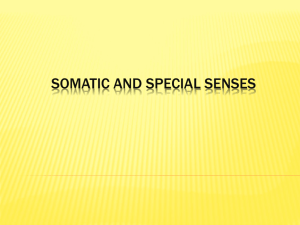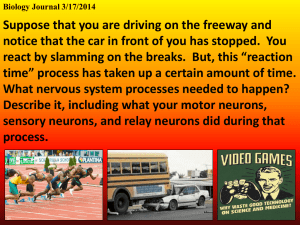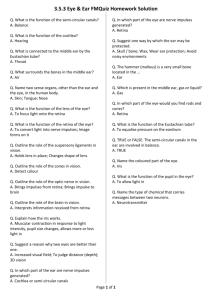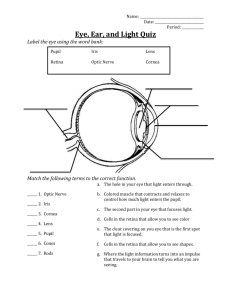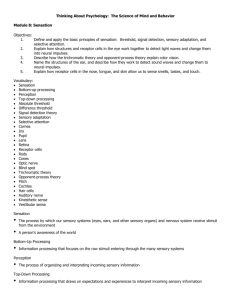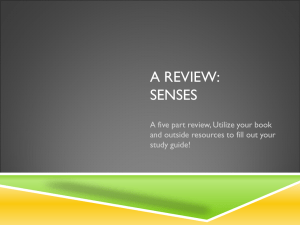Chapter 12 Sensory Mechanisms • Receptors Receive and Convert
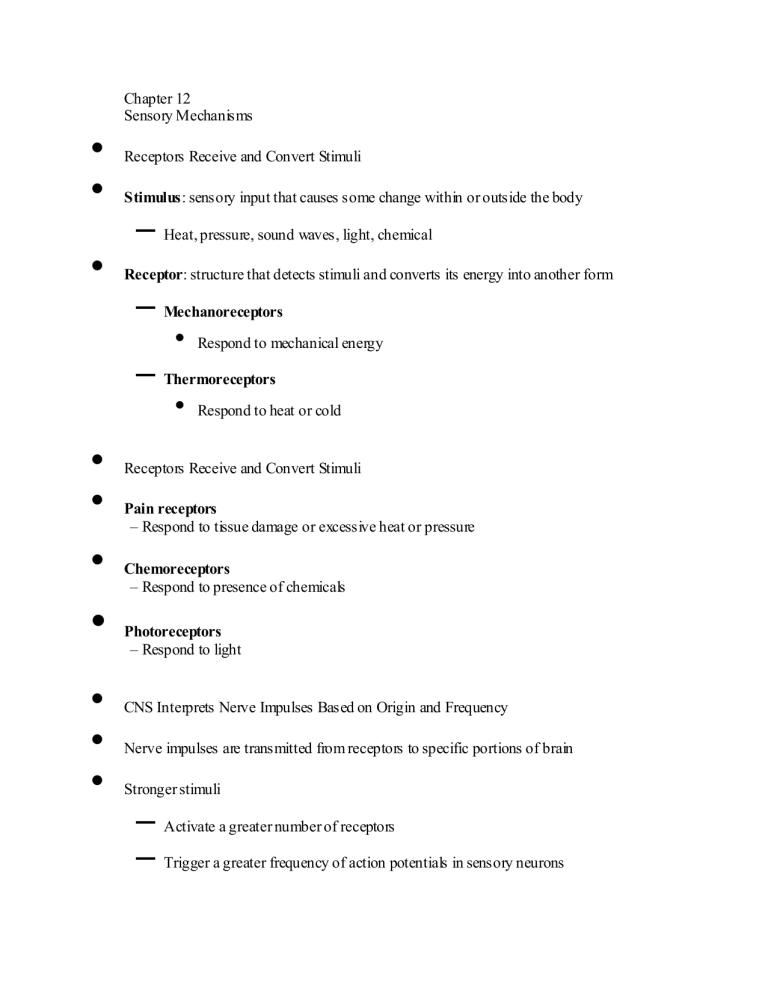
•
•
•
Chapter 12
Sensory Mechanisms
•
•
Receptors Receive and Convert Stimuli
Stimulus : sensory input that causes some change within or outside the body
–
Heat, pressure, sound waves, light, chemical
•
Receptor : structure that detects stimuli and converts its energy into another form
–
Mechanoreceptors
•
Respond to mechanical energy
–
Thermoreceptors
•
Respond to heat or cold
•
•
Receptors Receive and Convert Stimuli
Pain receptors
– Respond to tissue damage or excessive heat or pressure
•
•
Chemoreceptors
– Respond to presence of chemicals
Photoreceptors
– Respond to light
CNS Interprets Nerve Impulses Based on Origin and Frequency
Nerve impulses are transmitted from receptors to specific portions of brain
Stronger stimuli
–
Activate a greater number of receptors
–
Trigger a greater frequency of action potentials in sensory neurons
•
•
Some Receptors Adapt to Continuing Stimuli
Sensory adaptation
–
Allows the CNS to concentrate on important stimuli and ignore noncritical ones to maintain homeostasis
•
Receptors that adapt
–
Light touch, pressure, and smell
•
Receptors that do not adapt
–
Pain, joint, and muscle monitoring receptors
•
•
Somatic Sensations and Special Senses Provide Sensory Information
Somatic sensations
–
Arise from receptors located throughout the body
–
Temperature, pressure, touch, vibration, pain, awareness of body positions
•
Special senses
–
Arise from receptors restricted to specific areas of the body
–
Taste, smell, hearing, balance, vision
•
•
Mechanoreceptors Detect Limb Position, Muscle Length, and Tension
Mechanoreceptors
–
In joints: detect joint position
–
In skeletal muscles: m uscle spindles
•
Specialized mechanoreceptors for monitoring muscle length, which relay information about limb position
–
In tendons: detect tension
•
•
Thermoreceptors Detect Temperature
Thermoreceptors near skin surface provide information about external environment
–
Surface thermoreceptors adapt quickly
•
Thermoreceptors in thoracic and abdominal organs monitor core temperature
–
Core temperature receptors do not adapt quickly
•
•
Taste: Chemoreceptors Bind with Dissolved Substances
Taste buds
–
Chemoreceptors bind with dissolved substances
–
Most are distributed around edge, front, back of tongue
•
Taste categories
–
Sweet
–
Salty
–
Sour
–
Bitter
–
Umami
•
•
Smell: Chemoreceptors Bind with Odorants
Olfactory receptor cells
–
Chemoreceptors that bind with odorants
–
Detect >1,000 different odorants
•
Correlation between taste and smell
–
Chewed food releases chemicals that come in contact with olfactory receptors
•
•
•
•
•
•
•
•
•
•
Hearing: Mechanoreceptors Detect Sound Waves
Properties of sound and sound waves
–
Loudness
•
•
Related to amplitude of sound waves
Measured in decibels
–
Pitch (tone)
•
Related to frequency (number of wave cycles/sec)
– higher frequency: higher pitch
– lower frequency: lower pitch
Outer Ear Channels Sound Waves
Pinna : outer visible portion of ear
Auditory canal : directs sound waves
Tympanic membrane (ear drum) : separates outer ear from middle ear
Middle Ear Amplifies Sound
Air-filled space with three small bones
–
Malleus (hammer), Incus (anvil), Stapes (stirrup)
•
Sound converted to vibrations of tympanic membrane, which then pass through these three bones in sequence
Several-fold amplification of sound
Stapes passes vibrations along to oval window from which they will enter the inner ear
(cochlea)
•
Auditory tube (eustachian tube)
–
Connects to throat
•
•
•
–
Equalizes pressure
The Inner Ear Sorts and Converts Sounds
Cochlea converts sound to action potential
Structure of cochlea
–
Looks like a coiled snail
–
Uncoiled, it is a tapered tube with two outer canals (vestibular and tympanic canals) and inner fluid-filled duct (cochlear duct)
–
Contains hair cells (mechanoreceptors), with hair-like extensions embedded in tectorial membrane
–
Organ of Corti
•
Hair cells (mechanoreceptors) and tectorial membrane
•
•
•
•
The Inner Ear Sorts and Converts Sounds
Vibrations of oval window pass through cochlear fluid as pressure waves
Pressure waves result in physical bending of hair cells in organ of Corti
Different pitched sounds result in stimulation of hair cells (mechanoreceptors) in different regions of the cochlea
•
•
•
•
Pitch is distinguished by the region of cochlea stimulated
Action potentials carried by auditory nerve to vestibulocochlear nerve to b rain
Inner Ear Plays an Essential Role in Balance
Vestibular apparatus
–
Three semicircular canals and vestibule
•
Contain hair cells (mechanoreceptors) embedded in gel-like material
•
Hair cells bend in response to movement
•
Sensing rotational movement
•
•
•
–
Movement of fluid in semicircular canals bends hair cells (mechanoreceptors)
•
Head position and linear acceleration
–
Movement of otoliths bends hair cells in vestibule ( utricle and saccule )
•
•
Vision: Structure of the Eye
Vision involves detecting and interpreting visual stimuli by converting light energy to nerve impulses and transmitting them to the brain
•
Structures
–
Sclera (whites of the eye) and cornea
–
Aqueous humor, iris, lens
–
Vitreous humor, retina, optic nerve
–
Macula, optic disc
•
•
Regulating the Amount of Light and Focusing the Image
Regulating light
–
Iris opens or closes to control amount of light entering the eye
•
Focusing
–
Includes bending of light by cornea and lens
–
Accommodation
•
Adjustment of lens curvature to enable focusing on near and far objects
•
Made possible by ciliary muscle
Eyeball Shape Affects Focus
Normal shape allows focusing on the retina
Myopia: nearsighted
–
Eye longer than normal
–
Distant objects focus in front of retina
–
Corrected with concave lenses
•
Hyperopia: farsighted
–
–
–
Eye shorter than normal
Near objects focus behind the retina
Corrected with convex lenses
•
Astigmatism:
–
Irregularities in cornea or lens
–
Corrected with specially ground lenses that compensate for lens irregularities
•
•
Light Converted to Action Potentials
Retina
–
Allows us to see in color, adapt to varying light intensities, and perceive images
–
Layers of retina
•
•
•
•
Outermost: pigmented cells, absorb excess light
Photoreceptors: rods and cones
Bipolar cells: synapse with rods and cones
Innermost: ganglion cells, axons become the optic nerve
•
•
Rods and Cones Respond to Light
Photoreceptors
–
Rods and cones
•
•
Response to light: photopigment (protein) changes shape
Rods: approximately 120 million
•
•
•
•
•
•
•
•
•
Cones: approximately 6 million
–
1 million ganglion cells
–
Significant amount of convergence
Rods Provide Vision in Dim Light
Rhodopsin: photopigment within rods
–
More sensitive to light than the photopigment in cones
•
In dim light, vision primarily dependent on rods
•
•
Rods do not enable color vision
The farther from the fovea, the greater the density of rods
Cones Provide Color Vision and Accurate Images
Three types of cones enable color vision
–
Red, green, blue
•
Brain interprets ratios of impulses coming from ganglion cells connected to the three kinds of cones
Cones require stronger light to be activated
Cones responsible for visual acuity
Disorders of the Ear
Deafness : loss of hearing
–
Nerve deafness: damage to hair cells
–
Conduction deafness: damage to tympanic membrane or bones of middle ear
– In some cases, can be corrected with a cochlear implant
•
Otitis media
– Inflammation of the middle ear
•
Ménière’s syndrome
– Inner ear condition impairs hearing and balance
•
•
Disorders of the Eye
Retinal detachment
–
Retina separates from choroid
•
Cataracts
–
Lens becomes opaque
•
Glaucoma
–
Pressure inside the eye rises due to improper draining of aqueous humor
–
If untreated, may lead to blindness
